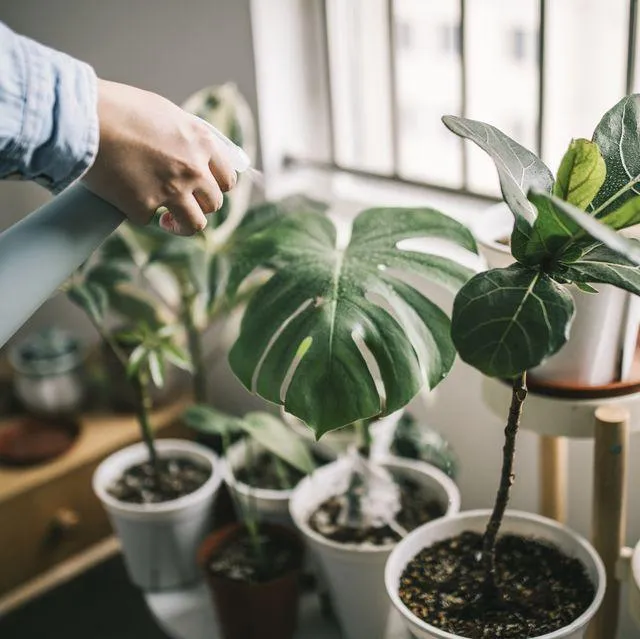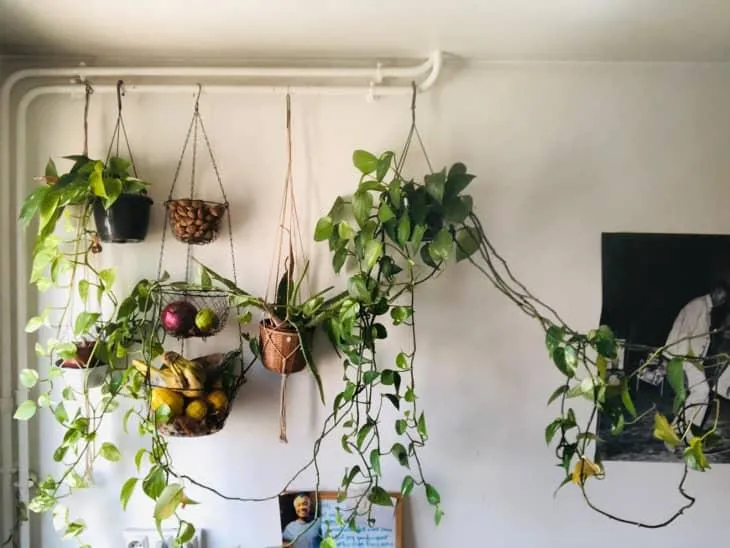The Best Indoor Plants to Jazz Up Your Home
Whether you’re looking to add some greenery to your living space or want plants that require minimal maintenance, hanging indoor plants are a great option. From my experience maintaining both indoor and outdoor plants, hanging varieties tend to be quite forgiving as long as they get the right care. In this article, I’ll cover some of the top hanging plant picks that not only look beautiful but also thrive in average indoor conditions.
Pothos
- Scientific name: Epipremnum aureum
- Care level: Very easy
- Light requirements: Low to bright indirect light
Pothos is basically the definition of a low-maintenance houseplant. Kind of like the jean shorts of the plant world – it’s easygoing and will look good in just about any space. I’ve seen pothos survive some pretty neglectful owners! The trailing vine growth habit makes it perfect for hanging baskets or letting spill over the sides of shelves. Its heart shaped leaves come in various colorations like plain green, variegated, or with splashes of yellow. Water when the top inch of soil dries out and you’ll be rewarded with a full, lush hanging plant. Pothos is surely one of the best hanging indoor plants for beginners.
Philodendron
- Scientific name: Philodendron hederaceum
- Care level: Easy
- Light requirements: Low to medium light
Much like pothos, philodendron is renowned for being practically indestructible. I have a philodendron that’s been in my home for well over a decade – it was passed down from my grandma, believe it or not! This vining plant has heart shaped leaves too, albeit much larger, that come in solid green or variegated varieties. The vines can get quite lengthy, making it perfect for draping over an archway, hanging basket, or allow it to trail down walls. Water when the soil becomes dry and provide supplements of diluted liquid fertilizer in the growing season for extra lush growth. Philodendron offers big impact for such low effort.

English Ivy
- Scientific name: Hedera helix
- Care level: Easy to medium
- Light requirements: Low to bright indirect light
English ivy has kind of got a bad rap over the years for being invasive outdoors, but contained in pots it makes for a great hanging indoor thriller plant. The small, glossy leaves form dense mats of foliage in shades of green or intricately variegated cream and gold. English ivy thrives on neglect and can go quite a long time between waterings when the soil dries out. Like philodendron, let it trail down and its vining stems will root wherever they touch. English ivy cascading over the sides of bookshelves or draping from ceiling to floor looks absolutely stunning, in my opinion. It’s a brilliant choice if you’re looking for drama.
Spider Plant
- Scientific name: Chlorophytum comosum
- Care level: Easy
- Light requirements: Low to medium light
I’ll be real with you – I’ve sort of got a love-hate relationship with spider plants. On one hand, they seem virtually indestructible and pump out loads of baby plantlets (called plantlets – sorta funny, right?). So in that respect, they’re an easy plant to keep around. But the leaf variegation isn’t super interesting to look at, if I’m being honest. Still, spider plants get points for being basically foolproof and are quite attractive hanging in a cluster. Give them average indoor conditions and watch the plantlets grow – you’ll have a whole pot of trailing spider plants before long! Water when dry. Hands down, spider plants are the most durable of the hanging indoor plants.
English Laurel
- Scientific name: Prunus laurocerasus
- Care level: Easy to medium
- Light requirements: Low to medium light
This broadleaf evergreen shrub makes a lush, foliage-forward hanging indoor plant. The leathery dark green leaves have an amazing gloss to them. English laurel grows quite slowly, so it doesn’t outpace its allotted space quickly. You could hang a single pot for quite a while before needing to separate it. English laurel appreciates consistent moisture, so water when the top inch of soil feels dry. For extra credit, prune it periodically to maintain a full shape. Its unusual pale pink spring flowers add a surprising seasonal touch. While less common than some other picks, English laurel upstages most in beauty, if you ask me.

Peperomia
- Scientific name: Peperomia species
- Care level: Easy to medium
- Light requirements: Low to medium light
There are dozens of different peperomia varieties commonly available as houseplants – talk about variety! Some of my favorites include peperomia hope, peperomia obtusifolia variegata, and peperomia scandens. Each displays unique leaf textures and patterns in shades like green, red, yellow and more. Peperomias are epiphytic tropical plants, meaning they grow on other plants like trees in nature. So they love to climb and are perfect hanging beauties when given the chance to trail downward. Water infrequently, when dry about 1 inch down. Peperomia offers more visual interest than the average green hanging plant for similar care.
Hanging IvyGeranium
- Scientific name: Pelargonium peltatum
- Care level: Easy to medium
- Light requirements: Medium to bright light
For a pop of bright color, hanging ivy geranium is a top pick. Its cascades of tongue-shaped leaves emerge in stripes, splashes, and solids of fuchsia, rose, salmon, and white. Hanging baskets filled with a variety of ivy geraniums’ vivid blooms really jazz up a space in my opinion. You’ll get the most colorful foliage and flowers with exposure to direct sun for a few hours daily. Ivy geraniums do appreciate consistent moisture too – when the top half inch dries out is a good rule of thumb for watering. Deadhead spent blooms to encourage continuous flush. What’s not to love about this vibrant spiller? It’s one of the best hanging plants for adding colorful charm.
Neon Pothos
- Scientific name: Epipremnum aureum ‘Neon’
- Care level: Very easy
- Light requirements: Low light
Alright, full disclosure – I’m kind of obsessed with neon pothos. It takes the classic pothos to a whole new level with shockingly bright chartreuse leaves that practically glow. Having had many varieties of hanging plants over the years, I have to say neon pothos is one of the showiest. The intense lime color really pops whether hanging in a crowded space or left to trail down in a long cascade for high-impact visual interest. Neon pothos is as low maintenance as they come – just the average pothos care. But it brings next-level vibrancy, kind of like adding neon rainbow tie dye accents to the whole room, if that makes sense, LOL! It’s a stunner for high-energy modern spaces in my humble opinion.

Chinese Evergreen
- Scientific name: Aglaonema species
- Care level: Easy to medium
- Light requirements: Low light
No collection of top indoor hanging plants would be complete without Chinese evergreen. Sure, it doesn’t vine or trail like previous picks, but there are compact and mounded varieties perfect for hanging baskets. Chinese evergreen offers such unique leaf shapes and patterns – from broad arrowhead forms to narrow lance leaves streaked and spotted in shades of green, cream, pink, red and more. I love the drama and texture these tropical evergreen foliage plants bring. Keep soil lightly moist and provide moderate indirect light. Chinese evergreen ranks among the hardiest and most distinctive hanging houseplants around if you ask me. Its statement leaves are long lasting too.
Hope
Plants for Indoor Hanging Baskets
| Name | Watering Needs | Light Needs | Size |
|---|---|---|---|
| Pothos | Allow soil to dry between waterings | Low to medium | Trails up to 6 feet |
| Tradescantia zebrina | Water when top 1-2 inches of soil dry | Medium to bright indirect | Trails up to 3 feet |
| Spider plant | Water when soil feels dry | Bright indirect light | Hangs up to 2 feet |
| Philodendron | Water when topsoil becomes dry | Low to bright indirect light | Vines up to 10 feet |
| English ivy | Water when topsoil becomes dry | Low to bright indirect light | Vines indefinitely |
FAQ
- What kinds of houseplants are easy to care for?
Some of the best plants to hang indoors that are pretty simple to look after include pothos, spider plants, philodendron, and english ivy. These sorts of trailing vines can hang nicely in a basket and don’t need a ton of sunlight or water to thrive. - Do hanging plants need special care?
Hanging plants are pretty much the same as regular plants when it comes to care – they need sunlight, water, and occasional fertilizer. The only difference is that hanging plants usually dry out faster than plants in pots on the floor, so you may need to water them a bit more regularly. Other than that, they’re pretty low maintenance. - What kind of container is best for hanging plants?
Most hanging plants do well in baskets, boxes, or pots with drainage holes. Just be sure the container isn’t too big – you want the plant’s roots to fill about half to three-quarters of the potting area. Macrame hangers or string works for suspension. Terra cotta and woven or plastic planters all function well. - Won’t hanging plants get top heavy?
It’s possible for a hanging plant to get heavy on top over time. Thankfully there are a few things you can do to prevent this. Choose a sturdy hanger or hook that can support the weight. You can also use multiple hooks or links of chain attached to the ceiling for extra security. And be sure to rotate plants occasionally so new growth fills in evenly. - What if my hanging plants don’t get enough sunlight?
If a hanging plant is looking pale or leggy from lack of light, you have some options. First, move it to a spot with brighter indirect sunlight if possible. You can also supplement with a grow light or just rotate the plant occasionally to give all sides exposure. Spider plants, pothos and philodendrons will survive with less sunshine compared to other kinds of greenery. - Are any hanging plants toxic to pets?
A few types of hanging plants can cause issues if ingested by pets. Spider plants, while very tough, contain calcium oxalate crystals that can irritate mouths and cause vomiting. English ivy and certain pothos varieties contain compounds that may induce collapse in cats or dogs. Consider choosing pet-safe options like philodendrons or chlorophytum if you have inquisitive animals around.
Bottom Line
Hanging baskets and pots make planting indoors a breeze. Just stick to low-maintenance vines that prefer passive sunlight and occasional watering. Pothos, spider plants and philodendrons work beautiful in macrame or woven hangers. At the end of the day, choose varieties that suit your space and needs. Read care instructions for any new plant friend to keep it looking perky for years to come!

